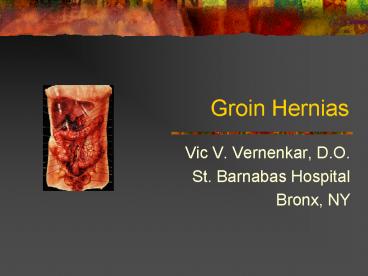Groin Hernias - PowerPoint PPT Presentation
1 / 39
Title:
Groin Hernias
Description:
Abnormal protrusion of a peritoneal lined sac thru the ... Ilioinguinal provides sensory to pubic region, upper labia, scrotum. Most commonly injured. ... – PowerPoint PPT presentation
Number of Views:2844
Avg rating:3.0/5.0
Title: Groin Hernias
1
Groin Hernias
- Vic V. Vernenkar, D.O.
- St. Barnabas Hospital
- Bronx, NY
2
Definition
- Abnormal protrusion of a peritoneal lined sac
thru the musculoaponeurotic covering of the
abdomen
3
Introduction
- In US 96 are inguinal, 4 femoral
- 20 bilateral
- Most common in both sexes indirect.
- Femoral hernias more common in elderly females
- Male to female ratio in 91 for inguinal hernias,
13 for femoral hernias
4
Anatomy
- 4cm in length
- 2-4 cm cephalad to inguinal ligament
- Extends between superficial and deep rings
- Contains spermatic cord or round ligament
5
Anatomy
- Bounded superficially by external oblique
- Cephalad by internal oblique, TA, transversalis
- Inferior border is inguinal ligament
- Floor is transversalis fascia
6
Layers
- Skin, subcutaneous, campers, scarpa, external
oblique fascia, cremaster, spermatic cord,
cremaster, transversus abdominis, transversalis
fascia, preperitoneal tissues, peritoneum
7
Anatomy
- Broadly classified as indirect and direct
depending on relationship to epigastric vessels. - Hesselbachs triangle is inferior epigastric
artery laterally, lateral border of rectus
medially, inguinal ligament inferiorly.
8
Anatomy
- An indirect hernia passes lateral to Hesselbachs
triangle. - A direct hernia passes thru Hesselbachs
triangle. - Indirect hernia has a congenital component, from
processus vaginalis. - The processus is supposed to obliterate after
descent of testes.
9
Hesselbachs Triangle
10
(No Transcript)
11
(No Transcript)
12
Indirect Hernia
13
Direct Hernia
14
Anatomy
- Direct hernias are usually not congenital.
- Acquired by the development of tissue
deficiencies of the transversalis fascia. - Development of femoral hernia less understood.
Can result from increased intraabdominal
pressure. The sac then migrates down the femoral
vessels into thigh.
15
Anatomy
- Major nerves in the region are ilioinguinal,
iliohypogastric, genitofemoral nerves. - Ilioinguinal provides sensory to pubic region,
upper labia, scrotum. Most commonly injured. - Iliohypogastric supplies sensory to skin superior
to the pubis. - Genitofemoral sensory to scrotum and thigh.
16
(No Transcript)
17
(No Transcript)
18
Diagnosis
- Careful physical exam
- Pain, dull dragging sensation
- A common reducible hernia does not cause
significant symptoms. - CT scan, US are adjuncts rarely needed.
- Cannot determine direct from indirect clinically.
19
Nyhus Classification
- I indirect, internal ring normal (kids)
- II indirect, dilated internal ring
- III posterior wall defects, direct inguinal
hernia, dilated internal ring, massive scrotal,
sliding, femoral hernia - IV recurrent hernia
20
Indications for Operative Repair
- Early repair is justified when potential for
strangulation is weighed against minimal risks
for surgery. - Not warranted in terminally ill without
incarceration - Patients with ascites should have it controlled
before surgery - Incarceration, strangulation
21
Surgical Techniques
- Open anterior repair (Bassini, McVay, Shouldice).
- Open posterior repair (Nyhus, preperitoneal)
- Tension-free repair with mesh(Liechtenstein,
Rutkow) - Laparoscopic
22
Open Anterior Repair
- Transversalis opened, hernia sac ligated, canal
reconstructed using permanent sutures. - Tension of the repair can lead to recurrence.
23
Open Posterior Repair
- Divide the layers of the abdominal wall superior
to the internal ring, enter preperitoneal space.
Dissection continues behind and deep to the
entire inguinal region. - Suture tension problems.
24
Tension-Free Repair
- Same initial approach as anterior repair
- Instead of sewing fascial layers together to
repair defect, a prosthetic mesh onlay used - Simple to learn, easy to perform, suited for
local anesthesia, excellent results with
recurrence less than 4.
25
(No Transcript)
26
(No Transcript)
27
Techniques
- Coined by Liechtenstein in 1989
- Central feature is polypropylene mesh over
unrepaired floor. - Gilbert repair uses a cone shaped plug placed
thru deep ring. - Slit placed in mesh for cord structures
28
Kugel Patch
29
Bard Perfix Plug and Patch
30
Prolene Hernia System
31
Techniques
- Suture fixation of the superior edge not needed.
- Reduction of the slit around the cord did not
reduce recurrences. - The additional safeguard was the plug
- Closing the tails is also not necessary.
- Tight rings do not cause orchitis, trauma does.
32
(No Transcript)
33
Techniques
- The genital branch of the femoral nerve, and the
ilioinguinal nerve are allowed to pass thru the
newly constructed deep ring. - Suturing the plug is not necessary.
- Preformed plugs have no advantage over a hand
fashioned one.
34
Techniques
- Small indirect sacs are dissected and inverted,
large one are transected and ligated. - Direct sacs are inverted.
- If plugs are placed to repair direct defects, a
mesh only must be placed over the plug to prevent
expulsion.
35
Techniques
- Suturing the mesh to the inguinal ligament is not
important. - Fixing the mesh to the rectus sheath 1-1.5cm
medial and superior to the pubic tubercle is very
important. - Should have a surplus of mesh over inguinal
ligament, the medial suture ensures surplus mesh
inferiorly
36
Laparoscopic Procedures
- Increasingly popular, controversial
- Early in the development, hernias were repaired
by placing very large mesh over entire inguinal
region on top of the peritoneum. Was abandoned
because of contact with bowel. - Today, most performed TEP or TAPP
37
Laparoscopic Procedures
- In the TEP procedure, an inflatable balloon is
placed in the preperitoneal space, and the repair
is done preperitoneal. More skill required. - In both TAPP and TEP, the hernia sac is reduced,
and a large piece of mesh is placed to cover
defects.
38
Laparoscopic Procedures
- The argued advantage of these procedures was less
pain and disability, faster return to work. - Great for bilateral hernia, with no increase in
morbidity. - For recurrent hernia
- Disadvantages are cost, time.
39
Recurrence































